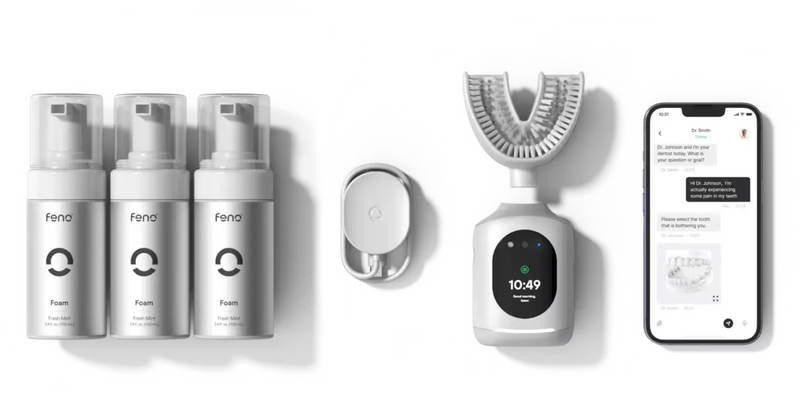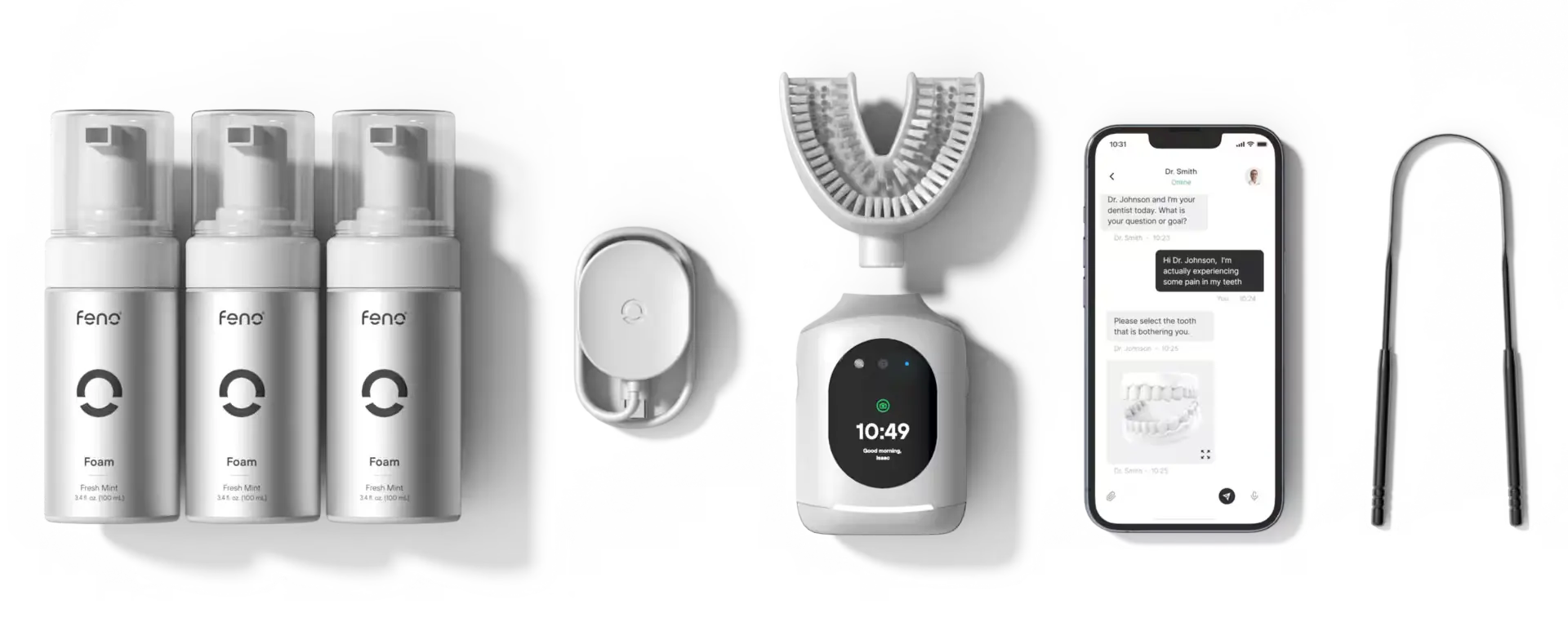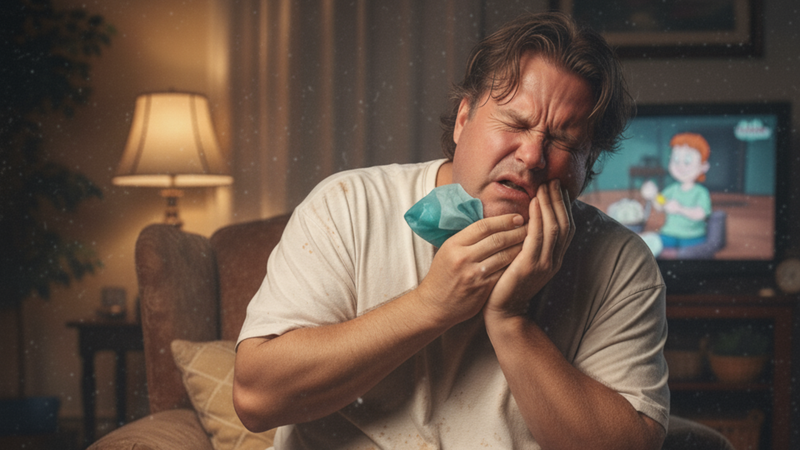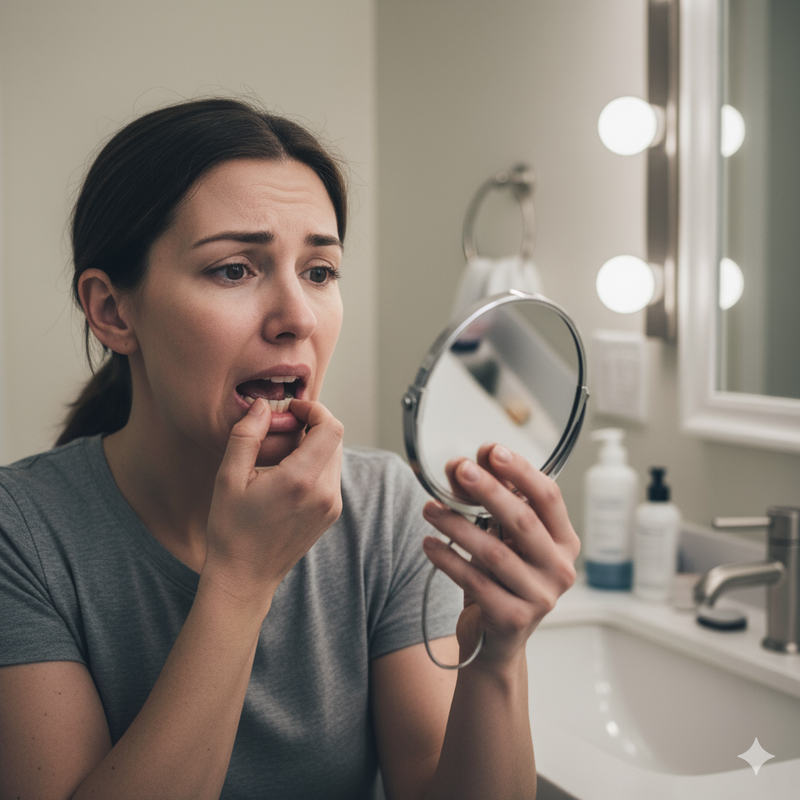
Best Practices For Using A Full-Mouth Toothbrush
Essential Takeaways
- The full-mouth toothbrush is a new electric toothbrush designed to clean all your teeth at once. It's claimed to be more efficient and effective than traditional toothbrushes.
A full-mouth toothbrush represents a revolutionary approach to dental care, designed to enhance the effectiveness and efficiency of our daily oral hygiene routine. Unlike traditional toothbrushes that clean one section of the mouth at a time, a full-mouth brush offers a comprehensive cleaning solution. This innovative dental tool is crafted to clean multiple tooth surfaces simultaneously, improving the quality of the cleaning.
Comparison with Traditional Toothbrushes and Other Tools
Full-mouth toothbrushes differ significantly from traditional toothbrushes in both design and usage. While traditional brushes require manual movement to clean one or two teeth at a time, these toothbrushes use a U-shaped mouthpiece to clean all teeth simultaneously, reducing brushing time and effort. This makes them especially appealing for people with limited dexterity or those seeking convenience. However, traditional toothbrushes offer greater control and precision, allowing users to target specific areas, adjust pressure, and select bristle types to match their needs. In contrast, full-mouth models may not reach every crevice with the same accuracy, particularly for individuals with unique dental alignments. When compared to other dental hygiene tools, such as water flossers and interdental brushes, full-mouth toothbrushes focus on cleaning tooth surfaces. In contrast, water flossers and interdental brushes are designed to clean between teeth and along the gumline, areas that even advanced brushes may miss. For optimal oral health, combining these tools can provide more comprehensive care.

Understanding Full-Mouth Toothbrushes
What is a Full-Mouth Toothbrush?
This innovative device typically features a U-shaped brush head that contours around the teeth, enabling it to brush multiple surfaces at once. By surrounding the entire dental arch, this toothbrush minimizes the effort and time required for thorough cleaning, making it an attractive choice for individuals looking to optimize their oral care routine.
Types: Manual vs. Electric
There are two main types of whole-mouth toothbrushes: manual and electric. Manual full-mouth toothbrushes require the user to scrub their teeth manually, similar to traditional toothbrushes, but with the advantage of a more enveloping brush head. On the other hand, whole-mouth electric toothbrushes use battery power to provide automatic brushing motions. Many brushing modes designed to meet different dental care needs are frequently included in this cutting-edge technology.
Advantages Over Traditional Toothbrushes
Electric toothbrushes with advanced ergonomic designs are particularly advantageous for individuals with limited dexterity, such as those with arthritis, elderly users, or anyone who finds it challenging to use a standard manual toothbrush effectively. These toothbrushes are typically equipped with larger, non-slip handles that are easier to grip and maneuver, minimizing the strain on the hands and wrists during brushing. Furthermore, many models feature one-touch operation and are considerably lighter than traditional models, enhancing usability and comfort.
Benefits of Using a Full-Mouth Toothbrush
Improved Plaque Removal
One of the primary benefits of full-mouth toothbrush use is its superior plaque removal capabilities. The design allows for simultaneous contact with all tooth surfaces, effectively dislodging plaque from areas that might be missed by a standard toothbrush. Regular use of a full-mouth electric toothbrush can significantly reduce plaque buildup, lowering the risk of cavities and periodontal disease.
Enhanced Gum Health
Gum health is crucial to overall oral wellness, and full-mouth toothbrush tips can greatly contribute to healthier gums. By providing gentle yet thorough cleaning action along the gum line and between teeth, these toothbrushes help reduce gum inflammation and bleeding. Consistent use can prevent the development of gingivitis and other gum diseases, ensuring that your gums stay healthy and strong.
Effective Usage Techniques
Correct Brush Positioning
Proper toothbrush positioning is essential, especially when using a full-mouth toothbrush designed to cover more surface area in a single go. Such brushes, while efficient, require meticulous positioning to ensure that all areas of the mouth receive equal attention, promoting better oral hygiene and preventing dental problems.
-
Open Wide: Begin by opening your mouth enough to allow the full brush head to fit comfortably. This initial step is vital, as it ensures the brush can reach all parts of your mouth without restriction, enabling a comprehensive cleaning.
-
Insert Correctly: Carefully position the U-shaped head so that it wraps around your teeth. Start at the front of your mouth and gradually work your way back. This technique helps in covering each tooth uniformly, ensuring that each one is cleaned adequately from all angles.
-
Check Alignment: Once the brush is in place, confirm that it is properly centered. The bristles should contact all tooth surfaces equally to avoid missed spots. Proper alignment is crucial for effective brushing, as it ensures that every surface of the tooth, both front and back, is reached and cleaned effectively.
-
Adjust for Comfort: Adjust the position of the brush as necessary to prevent any discomfort or pinching along the gums. Comfort is key in maintaining a routine, as discomfort can lead to improper brushing habits or even deter you from brushing thoroughly.
-
Secure the Grip: Firmly grasp the handle to control the brush’s movement and stability during the cleaning process. A secure grip helps in maneuvering the brush accurately, allowing for targeted cleaning that adapts to the contours of your teeth and gums.
By following these steps, you ensure that the toothbrush works efficiently, maximizing contact between the bristles and both teeth and gums. Adopting correct brushing techniques not only promotes dental hygiene but also extends the longevity of your toothbrush.
Applying the Right Amount of Pressure
It is important to apply the right amount of pressure when using a full-mouth brush. Too much pressure can lead to gum recession and enamel wear, while too little might not effectively remove plaque. The ideal pressure is a gentle, firm pressing that allows the bristles to reach into crevices without causing discomfort. Many electric models feature pressure sensors that alert you if excessive force is being applied, helping to safeguard your oral health.
Ensuring Thorough Coverage
To ensure thorough coverage with a full-mouth toothbrush, it is essential to allow the toothbrush to reach every part of each dental surface. Even though the brush is designed to cover all areas at once, slight adjustments in the position can help target specific areas more effectively, especially if dealing with persistent plaque or when focusing on the gum line for improved gum health.
Incorporating a Full-Mouth Toothbrush into Daily Routine
Optimal Brushing Times
Dentists universally advise brushing your teeth at least twice daily. This routine typically includes brushing once in the morning and again before going to bed. The morning brush plays a crucial role in removing bacteria that multiply in the mouth overnight, helping maintain dental health and freshening breath to start the day. Evening brushing is equally important as it clears away the day’s accumulation of food particles and plaque.
Incorporating a midday brushing session after lunch offers additional benefits. This practice is especially beneficial for individuals who consume foods high in sugars or starches, which can feed the bacteria in plaque, leading to increased acid production. These acids can attack tooth enamel for up to 20 minutes after a meal, making a quick brush an effective deterrent against decay. Moreover, midday brushing can help to dislodge food particles trapped between teeth and reduce the likelihood of staining from substances like coffee or tea. It also refreshes breath, which can be a social benefit, particularly in professional or close-contact environments.

Frequency of Brush Head Replacement
To maintain the effectiveness of your full-mouth toothbrush, it's important to replace the brush head regularly. Typically, brush heads should be replaced every three to four months, or sooner if the bristles become frayed. Keeping track of the brush head’s condition ensures that you are always brushing with effective tools.
Pairing with Toothpaste and Mouthwash
For the best results with your U-brush, it’s advisable to use toothpaste that complements your specific dental needs, such as fluoride toothpaste for cavity protection. Complementing the brushing with a suitable mouthwash can enhance oral hygiene by reaching areas that even a full-mouth toothbrush might miss, providing an extra layer of cleanliness and protection against bacteria.
Maintaining the Toothbrush for Longevity
It's important to clean both the brush head and the handle regularly to prevent the buildup of bacteria and other microbes. After each use, rinse the brush head thoroughly under tap water to remove any remaining toothpaste and debris. For a deeper clean, it's advisable to soak the brush head in antibacterial mouthwash or a denture cleaner solution periodically. This helps in disinfecting the bristles and eliminating any potential bacterial growth. The handle of the toothbrush, which does not usually come into contact with the mouth, should also be wiped down with a disinfectant wipe to keep it clean from hand-transferred germs.
Excessive water exposure can damage electronic components and potentially shorten the device's life. It is safe to rinse the head under water, but ensure that the body of the toothbrush, especially where the battery compartment and electrical connections are located, is kept away from prolonged water contact. If the toothbrush gets wet, it should be dried immediately to avoid internal water damage. Additionally, proper storage of the toothbrush can significantly impact its hygiene and durability. Storing the toothbrush in an upright position allows any excess water to drain away from the head, reducing the risk of mold growth and the spread of bacteria.
Troubleshooting Common Issues
Overcoming Battery Life Problems
Battery life issues can be a common frustration for users of electric toothbrushes, including those using a whole-mouth electric toothbrush. Here are steps to maximize the battery life and reduce the frequency of these problems:
-
Fully Charge Before First Use: Before using your electric toothbrush for the first time, make sure it is fully charged. This initial full charge conditions the battery, setting the stage for optimal performance throughout its lifespan. Conditioning the battery like this helps stabilize its chemical composition and can extend the number of charging cycles it can sustain before experiencing degradation.
-
Avoid Overcharging: To maintain the health of your toothbrush's battery, do not leave it on the charger indefinitely. Once the toothbrush has fully charged, unplug it. Overcharging can lead to battery degradation by causing unnecessary stress and heat buildup in the battery cells, which compromises their overall longevity and efficiency.
-
Regular Use: Batteries in electric toothbrushes perform best when they are used regularly. Allowing your toothbrush to sit idle for extended periods can lead to decreased battery efficiency and reduced life expectancy. Regular use keeps the battery active and prevents the buildup of residual charge, which can negatively impact battery health.
-
Store in a Cool, Dry Place: The environment in which you store your electric toothbrush can significantly impact its battery life. Batteries are sensitive to extreme temperatures; excessive heat can lead to battery swelling and reduced capacity, while cold can cause permanent damage to the battery’s internal structure.
-
Use the Correct Charger: It is crucial to use the charger that originally came with your toothbrush or one that the manufacturer recommends. Using an incorrect charger can lead to issues such as improper charging speed and voltage mismatches, which might not only harm the battery but also pose a safety risk. Ensuring charger compatibility is essential for maintaining battery health and safety.
Understanding and implementing these steps can greatly enhance the experience of using an electric toothbrush by minimizing battery-related issues. Proper care and maintenance not only extend the lifespan of the toothbrush but also ensure it remains effective and efficient in promoting dental hygiene.
Solutions for Sensitive Teeth and Gums
For those with sensitive teeth and gums, a full-mouth toothbrush can sometimes feel overwhelming. To address this, start by selecting a model with adjustable intensity settings. Use the lowest or a sensitive mode to reduce discomfort. Look for brush heads specifically designed for sensitive teeth, which typically feature softer bristles and a gentler cleaning action.
How to Buy a Full-Mouth Toothbrush
Comparing Models and Brands
Comparing different models and brands is crucial to finding the best whole-mouth toothbrush for you. Assess the brush's battery life, the variety of brush heads available, and the warranty offered by the manufacturer. Reading user reviews can also provide insight into the reliability and effectiveness of different models, helping you make an informed decision based on user experiences.
Cost, Availability, and Purchasing Considerations
There are factors related to the cost, available models and brands, where to purchase, and ongoing maintenance needs associated with full-mouth toothbrushes. Popular models include options from brands such as Feno with unique features and accessories. These toothbrushes can be purchased directly from brand websites, dental supply stores, or major online retailers. Ongoing maintenance includes regularly replacing brush heads, properly cleaning, and caring for batteries, all of which are essential for ensuring long-term effectiveness and hygiene.

Recommended Retailers and Online Stores
When selecting a full-mouth electric toothbrush, the choice of retailer or online store plays a crucial role in ensuring a satisfying purchase. Buying directly from the official brand websites can be advantageous, as they often provide comprehensive product information, easy warranty registration, and dedicated customer support. For those who prefer a more tailored selection, dental supply stores are ideal as they stock dental products recommended by oral health professionals. Big-box retailers typically carry a broad array of oral hygiene products, often at competitive prices. Lastly, health and wellness e-commerce platforms specialize in high-quality dental products that may not be available in mainstream outlets.
Embracing how to use a full-mouth toothbrush with correct techniques and maintenance practices can transform your oral hygiene routine. The benefits of a full-mouth toothbrush are clear, from improved plaque removal and gum health to reduced brushing time and comprehensive oral coverage. By carefully selecting the right model that suits your needs and following the guidelines outlined, you can enjoy a healthier, more radiant smile. Experience a faster, more effective clean and upgrade your daily oral care routine with Feno's advanced full-mouth brushing technology.

Feno Founders Edition Bundle
Advanced Oral Health in 20 Seconds with the Feno Smartbrush™
Get Yours Now!





